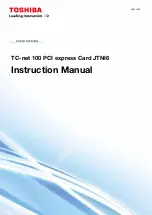
4. Function
DIO-32DM2-PE
39
4.
Function
This section describes the features of the product.
Function Outline
Overview
As this product supports transfer by bus mastering, it can be used as a pattern generator that samples or
outputs arbitrary digital patterns at high speed. It can also be used as a general-purpose I/O board
when bus mastering is not used.
Sampling function / generating function
This product can be used in three I/O modes: 32channels input, 16channels input/output,
32channels output. As the sampling and generating features have their own bus mastering blocks each
made up of two independent channels, the product can generate 16 signals while sampling 16 signals.
For sampling and generating, this product can input and output patterns at up to 20 MHz using the
internal clock. If it is too late for transfer because of failing to seize a bus, it causes an error and stops
transfer because it uses bus mastering. Note that it depends, for example, on the operating status of
applications on the PC whether the product can perform continuous transfer at 20 MHz.
For sampling and generating, this product can input/output data in various combinations of the start,
clock, and stop conditions.
Bus Master Transfer
Bus mastering by this product enables DMA for direct transfer between the product and the memory
space allocated for the application when the PCI Express bus is free. For the application's memory
space, a static area is specified, which is allocated by normal definition of a variable. Under the
Windows operating system, memory space for applications is represented by logical addresses and
physical addresses make up noncontiguous address spaces. This product transfers data continuously to
the noncontiguous address space. Bus mastering enables transfer to up to 64 megabytes of physical
memory space. When the area for an application to transfer data to is set, the amount of allocatable
memory depends on the type of the OS and on the actual memory size of the PC.
For bus mastering, the product supports one-time transfer and ring transfer different in how it uses
memory. During one-time transfer, the product completes transfer when it reaches the end of the
allocated memory area. During ring transfer, the product starts transfer over again from the beginning
of the allocated memory area when it reaches its end. Ring transfer continues until a stop condition is
satisfied or until it is terminated by software.
Summary of Contents for DIO-32DM2-PE
Page 7: ...vi DIO 32DM2 PE ...
Page 33: ...2 Setup 26 DIO 32DM2 PE ...
Page 45: ...3 External Connection 38 DIO 32DM2 PE ...
Page 57: ...5 About Software 50 DIO 32DM2 PE ...
Page 62: ......
















































